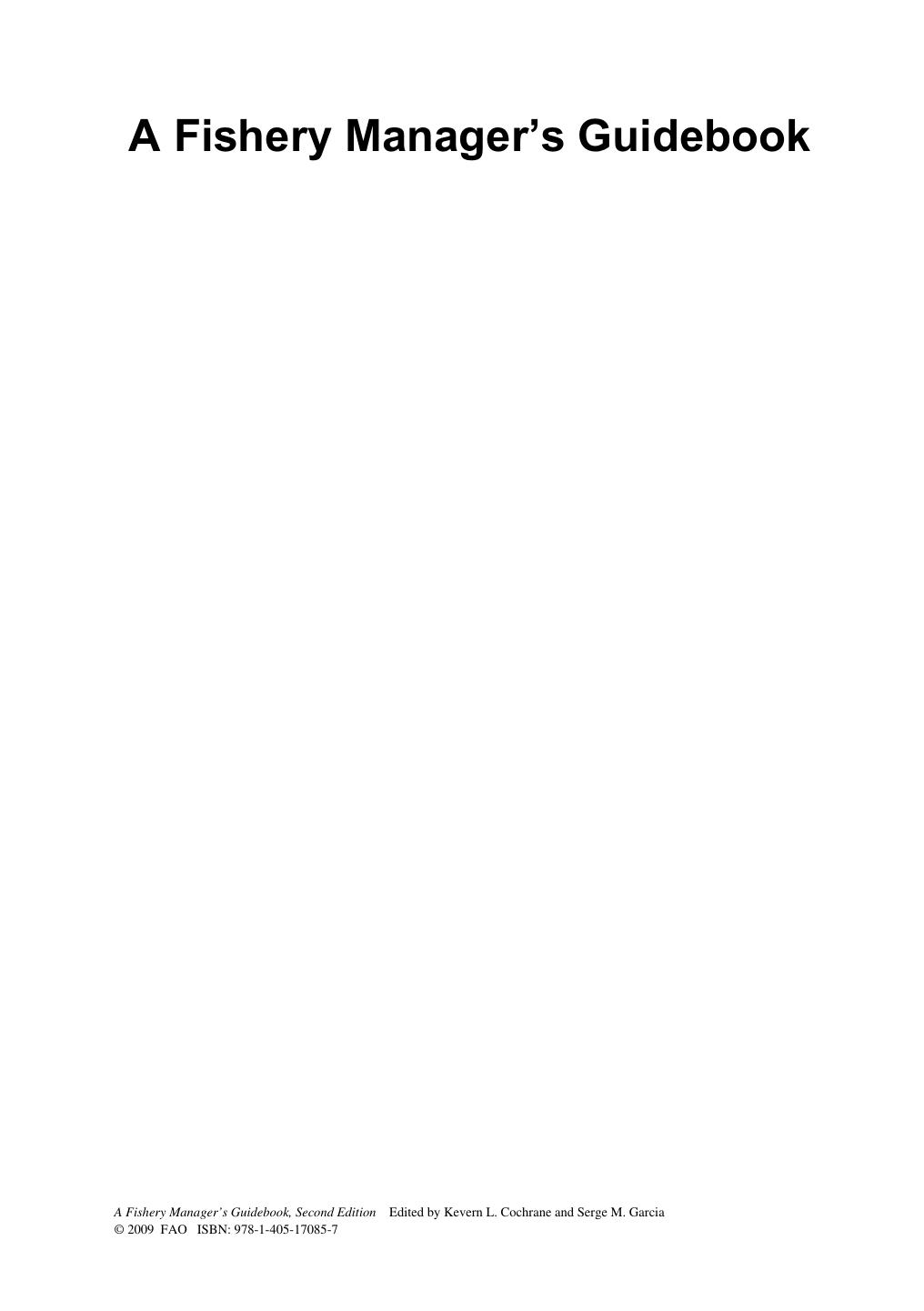A Fishery Manager is Guidebook 2nd Edition by Kevern Cochrane, Serge Garcia 1405170859 9781405170857
$70.00 Original price was: $70.00.$35.00Current price is: $35.00.
Instant download Fishery Manager’s Guidebook 2nd Edition A after payment
A Fishery Manager is Guidebook 2nd Edition by Kevern Cochrane, Serge Garcia – Ebook PDF Instant Download/Delivery: 1405170859, 9781405170857
Full download A Fishery Manager is Guidebook 2nd Edition after payment

Product details:
ISBN 10: 1405170859
ISBN 13: 9781405170857
Author: Kevern L. Cochrane; Dr Serge M. Garcia
Co-published with the Food and Agriculture Organization of the United Nations. Fisheries management is the process that has evolved to try to ensure that fisheries operate in a manner that provides the immediate benefits in a sustainable manner. The widely accepted goal is that the full range of benefits should not only be available for this generation but for generations to come. Fisheries management has been successful in some cases but there have also been many, many cases of failure.
This volume is intended to contribute to improving this unsatisfactory state by addressing the widespread need for information and guidance on the broad and often complex task of fisheries management. It is an updated and expanded edition of the first version of “A fishery manager’s guidebook” which was published as a FAO Fisheries Technical Paper in 2002.
The major part of this new edition is divided into five parts intended to cover the range of concerns, tools and techniques essential to the modern fisheries manager, whether that manager is an individual or a formal or informal group. Following the Introduction:
- Part I examines the primary dimensions of fisheries: biological, ecological, social and economic
- Part II looks at the legal and institutional characteristics of fisheries
- Part III explores the tools that fishery managers have to achieve the objectives expected from a fishery
- Part IV discusses the role of scientific information of indicators and reference points
- Part V moves into implementation of fisheries management and includes a chapter on special considerations in small-scale fisheries
This landmark publication is aimed at fishery managers and scientists. All libraries in research establishments and universities where fisheries and aquatic sciences are studied and taught will need copies of this important volume.
Fisheries around the world make essential contributions to human well-being including the provision of basic food supplies, employment, recreational opportunities, foreign currency and others, providing benefits to hundreds of millions of people. Despite these benefits, our record of managing fisheries so that the benefits can be sustained has been poor, at best, and most fisheries around the world are experiencing serious ecological, social or economic problems and usually all three. Today there is global concern about the state of fishery resources and aquatic ecosystems, their resilience to future stresses such as climate change and their ability to continue to provide benefits.
A Fishery Manager is Guidebook 2nd Table of contents:
Chapter 1 Introduction – Fisheries Management
1.1 Why do we need this handbook?
1.2 What is fisheries management?
1.3 The fisheries manager
1.4 Fisheries management and fisheries governance
1.5 Some working principles for fisheries management
1.6 An objective-driven process
1.7 Management plans, measures and strategies
1.8 The structure of this guidebook
Sources and recommended reading
Part I: The Primary Dimensions of Fisheries
Chapter 2 Biology and Ecology Considerations for the Fishery Manager
2.1 Introduction
2.2 Why marine resource managers need to know about biology and ecology
2.3 What managers need to know about biology and ecology
2.4 Emerging issues
2.5 Concluding comments
Acknowledgements
Sources and recommended reading
Web resources
Chapter 3 Social Aspects of Fisheries Management
3.1 Introduction
3.2 Dealing with the ‘tragedy of the commons’
3.3 Changing perspectives on resource management
3.4 Fisheries as linked social–ecological systems
3.5 Why broaden management objectives?
3.6 Is fishers’ knowledge relevant to management?
3.7 Why are institutions important?
3.8 The broader issues of fisheries governance
3.9 Synthesis and outlook
Acknowledgements
Sources and recommended reading
Web resources
Chapter 4 Economic Principles: An Economic Perspective on Fishing
4.1 An economic approach to fisheries
4.2 Bioeconomic reasoning and reference equilibriums
4.3 An economic perspective on fisheries regulations
4.4 Fisheries development
4.5 Synthesis
Sources and recommended reading
Part II: Legal and Institutional Considerations
Chapter 5 Legal Aspects
5.1 Introduction
5.2 Fisheries law
5.3 Fisheries management regime in the legal framework
5.4 Monitoring, control and surveillance
5.5 Significant issues and their legal aspects
5.6 Law review and the manager
5.7 Synthesis and outlook
Sources and recommended reading
Web resources
Chapter 6 The Fishery Management Institutions
6.1 Introduction
6.2 The manager in the institutional environment
6.3 Institutional environment and decision-making
6.4 Synthesis
Sources and recommended reading
Additional reading
Web resources
Part III: Management Measures and Tools
Chapter 7 Regulation of Fishing Gears and Methods
7.1 Introduction
7.2 Fishing gears
7.3 Passive fishing gears
7.4 Active fishing gears
7.5 Gear selectivity and ecosystem effects of fishing
7.6 Management considerations: selectivity and other ecosystem effects of fishing
7.7 Synthesis and outlook
Sources and recommended reading
Chapter 8 Area and Time Restrictions
8.1 What are area and time restrictions?
8.2 Why would you establish area or time restrictions?
8.3 What are the advantages and disadvantages of area and time restrictions?
8.4 Case studies
8.5 What are the practical steps towards establishing time and area restrictions?
8.6 Synthesis and outlook
Sources and recommended reading
Chapter 9 Input and Output Controls: The Practice of Fishing Effort and Catch Management in Responsi
9.1 Introduction
9.2 What are input and output controls?
9.3 Why would you want to use effort or catch management?
9.4 How would you impose fishing effort management and catch management?
9.5 What structures do you need for effort and catch management?
9.6 What problems exist with the application of effort management and catch management and how might
9.7 Where can you see examples of effort management and catch management in action?
9.8 Synthesis and outlook
Sources and recommended reading and web resources
Chapter 10 Rights-Based Fisheries Management: The Role of Use Rights in Managing Access and Harvesti
10.1 What is rights-based fishery management?
10.2 Why are use rights relevant to fishery management?
10.3 What initial considerations arise with use rights?
10.4 What forms of use rights are there?
10.5 What implementation decisions arise with use rights?
10.6 Synthesis
Acknowledgments
Sources and recommended reading
Chapter 11 Partnerships in Management
11.1 Introduction – partnerships solve problems, but are little known by managers
11.2 Partnerships of small and large scope
11.3 Partnerships of small and large scale
11.4 Partnerships with dual or multiple parties
11.5 Partnerships with different levels of community empowerment: accountability
11.6 Unusual partnerships solving particular equity problems: linking offshore fisheries to coastal
11.7 Power differentials of diverse actors on regional boards
11.8 Conditions for effective partnerships
11.9 Community partners may add value to the resource
11.10 Conclusion
Acknowledgements
Sources and recommended reading
Part IV: Scientific Information and Advice
Chapter 12 Which Indicators for What Management? The Challenge of Connecting Offer and Demand of Ind
12.1 Introduction
12.2 Evolution of the demand
12.3 Development of a system of indicators
12.4 Typology of indicators
12.5 Main issues and challenges
12.6 Synthesis
Sources and recommended reading
Web resources
Chapter 13 The Use of Scientific Information
13.1 Why and when are data and information needed in fisheries management?
13.2 Types of knowledge and the role of the scientist
13.3 Uncertainty and the precautionary approach
13.4 What tools can be used to generate information to advise management?
13.5 Scientific advice for management
13.6 Using the knowledge in decision-making
13.7 Presenting information to decision-makers
13.8 Adaptive management
13.9 Synthesis and outlook
Sources and recommended reading
Part V: Implementation
Chapter 14 Fishery Monitoring, Control and Surveillance
14.1 Introduction
14.2 The MCS solution
14.3 Core components
14.4 Facilitating for MCS
14.5 System performance and planning
14.6 Synthesis and outlook
Sources and recommended reading
Web resources
Chapter 15 Special Considerations for Small-Scale Fisheries Management in Developing Countries
15.1 Why small-scale fisheries need special consideration
15.2 Characterizing small-scale fisheries
15.3 A vision for small-scale fisheries
15.4 Substantive contribution of small-scale fisheries
15.5 Management objectives for small-scale fisheries
15.6 Management approaches for small-scale fisheries
15.7 Institutional arrangements for small-scale fisheries
15.8 Making a management plan for a small-scale fishery
15.9 Implementation of small-scale fisheries management
15.10 Capacity building for small-scale fisheries management
15.11 Emerging issues
Sources and recommended reading
Chapter 16 Fisheries Management Plans
16.1 Introduction
16.2 Designing a management plan
16.3 Implementation of management plans
16.4 Reviewing and amending management plans
16.5 FMP within the context of the EAF
16.6 Examples of management plans
16.7 Synthesis and emerging issues
Sources and recommended reading
Web resources
Part VI: Conclusions
Chapter 17 From Past Management to Future Governance: A Perspective View
17.1 Introduction
17.2 Historical trends
17.3 Emerging practices
17.4 The future of fishery governance
People also search for A Fishery Manager is Guidebook 2nd:
a fishery manager’s guidebook
ne fisheries management council
fish and fishery guide
2 fish guide service


